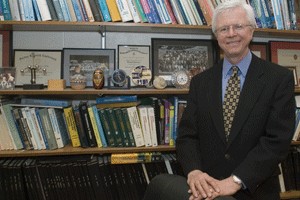
Ohio Third Frontier Awards Million-Dollar Grant to YSI-UC Team
The Ohio Third Frontier Commission has approved a $1,127,873 award to
, Riehl Engineering and the University of Cincinnati for their Advanced Modified Carbon Nanotube-Based Nutrient Sensor project.
University of Cincinnati Distinguished Research Professor William Heineman, in the McMicken College of Arts & Sciences,
, is officially part of the million-dollar team.
The project will produce an advanced nutrient sensor to enable critical monitoring of environmental waters for nitrate, which is a major pollutant associated with wastewaters and agricultural runoffs. Sensors are devices used to collect information about an environment, either remotely or by being located in the area being studied.
The carbon nanotube-based sensor will be able to measure the nitrate in an extremely fast, sensitive way, explains Heineman. The sensor will be a superior method of providing environmental quality control.
Nitrate is a chemical compound commonly found in fertilizers and formed by microbes that break down nitrogen-bearing plant residues in the soil. Storm water runoff washes these nitrates into streams and rivers. Nitrate, being a nutrient, feeds algae and other plants in the water. Too much nitrate causes growth surges, thus choking out the fish and other animals.
Nitrates that might be entering a communitys drinking water must be monitored by industries as mandated by several requirements and regulations, such as National Pollutant Discharge Elimination System permits under the Clean Water Act, the Safe Drinking Water Act, and the Emergency Planning and Community Right to Know Act. Up until now, such monitoring has been cumbersome, with sensors being approximately the size of a 45-gallon can and weighing about 80 pounds.
Thanks to the work of the team, the new sensors that are currently in development will be about one-third the size of a pencil, and will fit in a smart probe that is about the size of a AA flashlight. The team believes that this sensor will encourage many more industries and perhaps even individuals to monitor their runoff.
Once you
can
do it, people
will
do it more, says Kevin Schlueter, YSIs program manager for the project. A lot of companies have been asking for something like this.

'My job is to generate relevant research projects so that the students can learn how to do research,' says Heineman.
As part of the project, a Raman microscope worth more than a quarter of a million dollars will be purchased for the UC Sensor Instrumentation Laboratory. One UC graduate student will also be funded to work on this project.
There will be a dual benefit, explains Heineman. YSI will be able to use the instrument and my students and I will be able to use it as well.
There is a definite positive synergy to the project, Heineman notes.
YSI wants products I want projects for my PhD students. My job is to generate relevant research projects so that the students can learn how to do research. This grant enables them to help develop a sensor they wouldnt have ordinarily have had access to, he says. An added benefit is the opportunity for my students to learn about industry by rubbing elbows with YSI scientists working on this project.
UC chemistry has played a large role in the development of this particular product.
YSIs Schlueter earned his PhD in Chemistry at UC while studying under Brian Halsall and he did his post-doctoral research under Heineman and Halsall. YSI Biosensor Technologies Director Jay Johnson is also a PhD graduate of UCs Chemistry Department and a former student of Heinemans.
Ed King, Vice President of Research for YSI, did not go to UC, but he is another Ohio product, having graduated from Ohio Northern University.

Distinguished Research Professor William Heineman
This is a good Ohio story, King says. Through the Third Frontier Grants, were proliferating goodwill and jobs throughout Ohio.
Besides being of benefit to the communities of Ohio, the
Ohio Third Frontier Grants
also support education and further business development in Ohio. Ohios Third Frontier program helped in the
formation of about 14,000 direct and indirect jobs in the state in 2009
and nearly 55,000 direct and indirect jobs since the programs inception in 2002.
About the Third Frontier Sensors Program
The Ohio Third Frontier Sensors Program accelerates the development and growth of the sensors industry and its supply chain in Ohio. It is helping those organizations with near-term specific commercial objectives with respect to products, processes or services commercialize new products; commercialize manufacturing processes or technologies; adapt or modify existing components or systems that can reduce the cost and improve the functionality of sensors; address technical and commercial barriers or demonstrate market readiness.
Related Stories
Jason and Travis Kelce take Cincinnati to ‘New Heights’
April 16, 2024
UC alumni Jason and Travis Kelce returned to UC for an unforgettable evening that included the Great "Lombaby" Games, a live recording of their podcast "New Heights," special guests Joe Burrow, Orlando Brown Jr. and Desmond Ridder and a surprise commencement ceremony.
UC President Neville Pinto shares 2024 State of the University...
April 16, 2024
University of Cincinnati President Neville G. Pinto shared his 2024 Sate of the University address with the campus community on April 15.
Local 12: Nature still healing after Tristate storm that killed 4
April 12, 2024
Local 12 and other news media highlighted a long-term study by the University of Cincinnati examining the recovery of a forest damaged by a deadly tornado 25 years ago. The study found that the storm provided an opportunity for some nonnative, invasive species.
